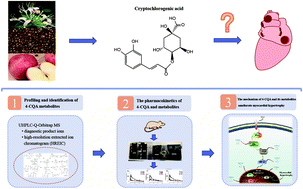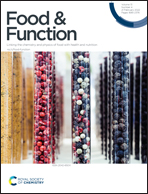Cryptochlorogenic acid and its metabolites ameliorate myocardial hypertrophy through a HIF1α-related pathway†
Abstract
Cryptochlorogenic acid (4-CQA) is a phenolic acid that has antioxidant and anti-inflammatory activities. Our preliminary study found that 4-CQA has a good effect on isoproterenol (ISO)-induced myocardial hypertrophy, while the mechanism remains largely unknown. This study aimed at delineating the metabolites and metabolic pathways of 4-CQA using liquid mass spectrometry and molecular biotechnology, exploring possible active metabolites and the mechanism of myocardial hypertrophy amelioration in H9c2 cells, and finally, investigating the pharmacokinetics of 4-CQA and its active metabolites in vivo. In summary, 56 potential effective metabolites were distinguished in rat urine, feces, plasma samples and heart tissue after intragastric administration of 4-CQA, and the main metabolic reaction types of 4-CQA included hydrogenation, methylation, glucuronidation, sulfation, hydration and their composite reactions in in vivo biotransformation. Besides, 4-CQA and its main active metabolites, caffeic acid and 4-O-feruloylquinic acid, significantly ameliorated pathological cardiac hypertrophy of H9c2 cells treated with ISO based on the Akt/mTOR/HIF-1α pathway. In addition, this study demonstrated that the prototype drugs 4-CQA and 4-O-ferulylquinic acid generally exhibit similar pharmacokinetic characteristics and caffeic acid presents relatively late peak time and low peak concentration in rats, which make them suitable candidate drugs.



 Please wait while we load your content...
Please wait while we load your content...